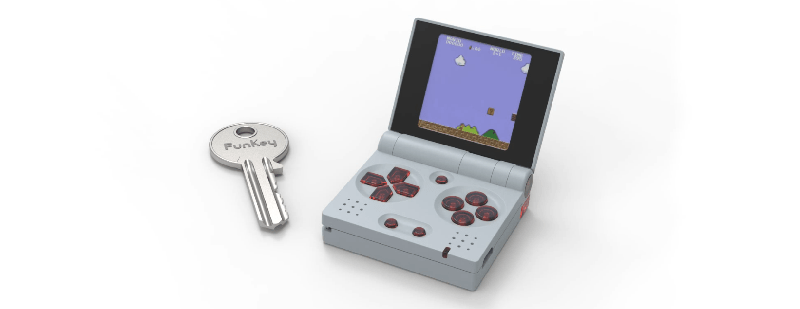If there’s one thing tiny Linux Systems on a Chip are good for, it’s emulation. There’s nothing like pulling out an emulation console on the bus for a quick game of old-school NES Tetris, or beating the next level in Super Mario World. This is the smallest emulation console ever. It’ll fit in your pocket, and it has a bright, vibrant screen. It doesn’t get better than this.
This project is an improvement on two projects, both of which are some of the top projects on hackaday.io, the best place on the Internet for hacks and builds. The Keymu is (or was, at the time) the smallest emulation console ever, built as a miniaturized version of the Game Boy Advance SP in a 3D printed case and powered by the Intel Edison. The Edison doesn’t exist anymore, so after that development moved over to the Funkey Zero, a tiny console built around the AllWinner V3s chip and a 240×240 display. Both of these are tiny, tiny consoles, but as silicon gets better there’s always better options, so it’s back to the drawing board.
The design of the Funkey Project is again built on the AllWinner V3S SoC with 64MB of DDR2 DRAM. There’s a 1.5″ display with 240×240 resolution, and of course this retro emulation console retains the classic and very useful clamshell form factor of the famous Game Boy Advance SP.
Already, this project is in the works and it’s shaping up to be one of the most popular projects on hackaday.io ever. Everyone wants an emulation console, and this is the smallest and tiniest one yet. Whether or not this project can carry through to production is another matter entirely, but we’re eager to find out.



















“smallest emulation console ever”? Did you guys already forget about Sprite_TM’s PocketSprite?
Hmm… probably depends how you’re measuring…
This is true, the PocketSprite is smaller overall. We actually planned to release a log soon that shows photos of the two put side by side. You’ll see we’re a bit thinner but larger (as it’s square shaped). We’ve never claimed to be the smallest because I don’t think we are, comfort of use is another matter though.
Here is the log is question:
https://hackaday.io/project/164934-funkey-project-all-your-games-on-your-keychain/log/162768-photo-shoot-side-by-side-with-pocketsprite
Pocket emulator in your pocket…
Is this a recursive thing? :)
Reminds me of a fun story in modern times where someone found a book about witchcraft and summoned a devil in a pentagon. That devil would come back later and do nasty things, no mater how big or small he would draw the pentagon. But he was a smart guy, and drew the pentagon on the chest of the devil and the next time it came it popped out of existance and into the pentagon recursively untill it popped out of existence.
Pentagram? If he knew drawing a pentagon, if that’s what it was, caused problems why would he keep doing it large and small?
It intrigues me too. From what I understand, large or small does not matter in the story, just that when the devil is summoned it is so inside the drawn pentagone.
So basically when he comes out later (which apparently it always does), if you draw a pentagone around the chest from which it would come out, it will recursively get summoned agin (within the limits of the pentagon) and then come back by itself again in the pentagone and then summoned again and on and on.
Is that it paul ?
larry niven. just read it last week.
I remember that one! Larry Niven maybe?
🎵 I’m the operator of my pocket emulator 🎶
Linux is way overkill for emulating an NES. ODROID has been doing it for years with an ESP32. https://www.hardkernel.com/shop/odroid-go/
Actually, less than a year. What about GBA, Genesis, PS1?
I get it, it’s The Smallest. However, a Game Boy Advance SP or even a DS Lite is already too small for comfort. I guess it’s good to know I’d have room for an extended run time battery.
i’m interested in the tipping point of when the people who are old enough to remember these games are too old to see these tiny displays
[Padrote]’s conjecture -make it happen +1 :)
I wonder where people keep getting these giant keys.
3D printers, dude.
Battery life is what, about 2hrs? LicheePi Zero (dev board they used to test) uses 0.1A and I guesstimate another 100mA for the screen. 420mAh battery = about 2 hrs.
The screen consumes a bit less than that, around 60mA, and the V3S as well. However there is also the audio coming out from the HP to consider. Worst case scenario with the three sources at maximum power, would yield around 2 and a half hours of battery time, around 3 and a half when the sound is off and even more if the screen backlight is not at full power.
+1 for the Kraftwerk reference